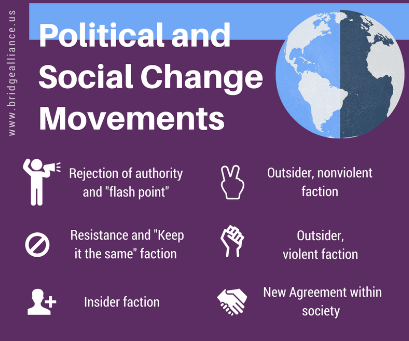Originally published in Bridge Alliance
Debilyn Molineaux, Bridge Alliance
In Part I The Cycle of Change, we explored the documented way culture has progressed through 500 years of Anglo-American history, as outlined in The Fourth Turning, by William Strauss and Neil Howe. The 80 (or so) year cycle, or saeculum, includes four turnings:
- High
- Awakening
- Unraveling
- Crisis
We entered the fourth turning, the crisis period, in 2008 with the financial crisis and “Great Recession”. Now we will explore the factions and their relationship with each other that demand and resist progress or social change.
Every great social change has predictable factions who advance or resist the solutions being called forth. These four factions are:
- The resistance
- The insiders
- The outsiders – nonviolent
- The outsiders – violent
Just since the American Revolution, we have seen the dance of these four factions in creating social change in clearly identifiable ways.
The American Revolution and the Civil War happened during a Crisis period of the saeculum. Suffrage and Civil Rights protests (heavily influenced by the Vietnam War protests) happened during Awakening periods. All of the resolutions became the law of our land, opening possibilities, more equality before the law, than existed previously. The Constitution itself was initiated as the insiders worked hard to negotiate and consider what was needed for a self-governing country. The Civil War consolidated federal power, denying states the right to secede. Suffrage added the 19th Amendment to the Constitution and the Civil Rights movement resulted in the Civil Rights Act of 1964 and Voting Rights Act of 1965.
The resistance to change is met with nonviolence and then violence. And the levels of violence are evenly matched between the resistance and the outsiders — during the Awakening, a consciousness shifting event will resolve the conflict. For Suffrage, it was the widespread news of women being tortured and force fed that shifted the tide. For Civil Rights, the assassinations and Watergate.
During a Crisis, the resistance (historically) does not surrender until forced — this is a “total” war. The old way of life is defended to the death by many. The loyalists were driven out of the newly formed United States during the American Revolution. In the Civil War, the South was humiliated in such a way that we still bear scars today.
Aren’t we all tired of bullying, tyranny and domination culture?
We have a few more years of this crisis…likely 10 or more…and the likelihood of a major war, unless we can find a dignified place in the new social contract for everyone. What would a world look like that honored everyone? From black men and women to older white people, from fundamentalist Christians to orthodox Muslims, from First Nation people to gun rights advocates, etc. What does dignity look like for you? For all?“Dignity is the stepping stone from liberty to justice.” ~Robert Fuller
What if our economy was set up with a human dignity framework? Instead of money being the metric of success, we determine how to measure happiness in our lives? Globalization, extremism and mass migrations have led to many of us living in our “survival mind”, thinking there is not enough. Not enough housing, work, food, support etc.
When we are living in our “survival mind”, we can and often do devolve into a “power over” or domination dynamic. This is the root of mass migrations, as people flee from poverty and tyranny; trade agreements that benefit corporations but leave workers behind; and ideological wars in which extremist views are appealing because of the security they profess.
We demand a dignified life. To have this we need to give up or reject domination culture. We want a system where contribution is rewarded, of course. Ideally, we want a system where survival mind is not needed for daily life. Our human spirit calls to be free and the happiest people we know are those who contribute to others. What is the economic system that rewards and supports free and happy people and disincentivizes domination? Perhaps it is an economic system waiting to be born. Remember, change is the only constant.
In Part III, we’ll explore our imminent change and what we can do to prepare.
Infographic by Jelmarie Rodriguez

